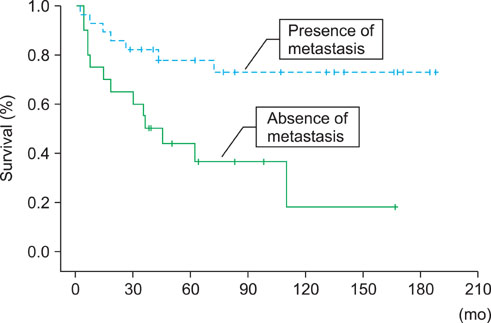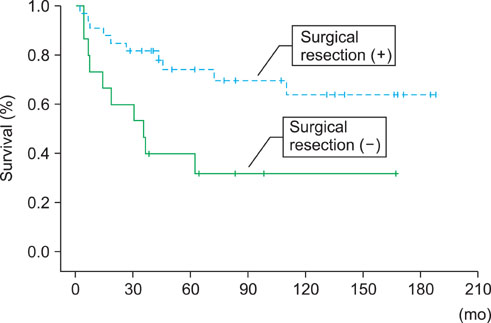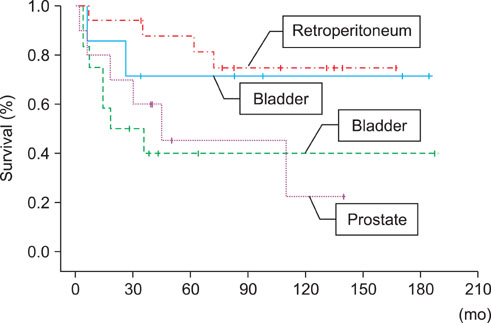Korean J Urol.
2011 Oct;52(10):669-673. 10.4111/kju.2011.52.10.669.
Prognostic Factors and Clinical Outcomes of Urological Soft Tissue Sarcomas
- Affiliations
-
- 1Department of Urology, Samsung Medical Center, Sungkyunkwan University School of Medicine, Seoul, Korea. bc2.jung@samsung.com
- KMID: 2061428
- DOI: http://doi.org/10.4111/kju.2011.52.10.669
Abstract
- PURPOSE
The purpose of this study was to elucidate prognostic factors for survival and clinical outcomes of rological soft tissue sarcomas (STSs).
MATERIALS AND METHODS
This was a retrospective review of the medical records of 48 patients with urological STS treated from January 1982 to July 2009. Demographic and pathological characteristics were compared. Patients' demographics, clinico-pathological parameters, overall survival, and the factors expected to predict survival, such as sex, age at diagnosis, primary organ, surgical resection, metastasis, and mass size, were analyzed. We evaluated differences in survival on the basis of histological subtype by Kaplan-Meier analysis and multivariate Cox proportional hazards regression.
RESULTS
The study included 34 males (70.8%) and 14 females (29.1%). The mean age at diagnosis was 47.1 years (range, 3 to 80). The most common site was the retroperitoneum (n=16), followed by the kidney (n=12), prostate (n=10), bladder (n=7), ureter (n=1), and paratesticular region (n=1). Nineteen patients (39.5%) had other organ metastases at diagnosis. The most common subtypes of sarcoma were leiomyosarcoma (50%), rhabdomyosarcoma (18.7%), and liposarcoma (8%). The remaining 11 cases had other histological subtypes (22.9%). Mean tumor size was 9.5 cm (range, 2.2 to 24). Thirty-three patients (68.7%) underwent surgical resection. The overall survival rate at 5 years was 51.4%. In the univariate and multivariate analysis, surgical resection, primary tumor site, and metastasis at diagnosis remained significant predictors of prognosis. Patients with retroperitoneal sarcoma had a higher overall survival rate by 5 years compared with patients with other organ sarcoma.
CONCLUSIONS
The overall survival rate at 5 years was 51.4%. Surgical resection, primary tumor site, and metastasis at diagnosis remained significant predictors of prognosis.
MeSH Terms
Figure
Reference
-
1. Jemal A, Murray T, Ward E, Samuels A, Tiwari RC, Ghafoor A, et al. Cancer statistics, 2005. CA Cancer J Clin. 2005. 55:10–30.2. Russo P, Brady MS, Conlon K, Hajdu SI, Fair WR, Herr HW, et al. Adult urological sarcoma. J Urol. 1992. 147:1032–1036.3. Stojadinovic A, Leung DH, Allen P, Lewis JJ, Jaques DP, Brennan MF. Primary adult soft tissue sarcoma: time-dependent influence of prognostic variables. J Clin Oncol. 2002. 20:4344–4352.4. Izumi K, Mizokami A, Sugimoto K, Narimoto K, Miyagi T, Maeda Y, et al. Role of surgical resection in adult urological soft tissue sarcoma: 25-year experience. Urol Int. 2010. 84:309–314.5. Mondaini N, Palli D, Saieva C, Nesi G, Franchi A, Ponchietti R, et al. Clinical characteristics and overall survival in genitourinary sarcomas treated with curative intent: a multicenter study. Eur Urol. 2005. 47:468–473.6. Nishimura J, Morii E, Takahashi T, Souma Y, Nakajima K, Doki Y, et al. Abdominal soft tissue sarcoma: a multicenter retrospective study. Int J Clin Oncol. 2010. 15:399–405.7. Zhang G, Chen KK, Manivel C, Fraley EE. Sarcomas of the retroperitoneum and genitourinary tract. J Urol. 1989. 141:1107–1110.8. Dotan ZA, Tal R, Golijanin D, Snyder ME, Antonescu C, Brennan MF, et al. Adult genitourinary sarcoma: the 25-year Memorial Sloan-Kettering experience. J Urol. 2006. 176:2033–2038.9. Dalal KM, Kattan MW, Antonescu CR, Brennan MF, Singer S. Subtype specific prognostic nomogram for patients with primary liposarcoma of the retroperitoneum, extremity, or trunk. Ann Surg. 2006. 244:381–391.10. Gutierrez JC, Perez EA, Franceschi D, Moffat FL Jr, Livingstone AS, Koniaris LG. Outcomes for soft-tissue sarcoma in 8249 cases from a large state cancer registry. J Surg Res. 2007. 141:105–114.11. Pacelli F, Tortorelli AP, Rosa F, Papa V, Bossola M, Sanchez AM, et al. Retroperitoneal soft tissue sarcoma: prognostic factors and therapeutic approaches. Tumori. 2008. 94:497–504.12. Perez EA, Gutierrez JC, Moffat FL Jr, Franceschi D, Livingstone AS, Spector SA, et al. Retroperitoneal and truncal sarcomas: prognosis depends upon type not location. Ann Surg Oncol. 2007. 14:1114–1122.13. Lewis JJ, Leung D, Woodruff JM, Brennan MF. Retroperitoneal soft-tissue sarcoma: analysis of 500 patients treated and followed at a single institution. Ann Surg. 1998. 228:355–365.14. van Dalen T, Plooij JM, van Coevorden F, van Geel AN, Hoekstra HJ, Albus-Lutter Ch, et al. Long-term prognosis of primary retroperitoneal soft tissue sarcoma. Eur J Surg Oncol. 2007. 33:234–238.15. Dotan ZA, Tal R, Golijanin D, Snyder ME, Antonescu C, Brennan MF, et al. Adult genitourinary sarcoma: The 25-year memorial sloan-kettering experience. J Urol. 2006. 176:2033–2039.16. Ramanathan RC, A'Hern R, Fisher C, Thomas JM. Modified staging system for extremity soft tissue sarcomas. Ann Surg Oncol. 1999. 6:57–69.
- Full Text Links
- Actions
-
Cited
- CITED
-
- Close
- Share
- Similar articles
-
- Stage Oriented Analysis of Soft Tissue Sarcomas
- Treatment Results of Soft Tissue Sarcomas in the Head and Neck
- A Case of Malignant Fibrous Histiocytoma on Nasal Dorsum
- The Result of Surgical Tratment of Soft - tissue Sarcoma
- Expression of Cyclin D1, CDK4, p16 and Rb Proteins in Human Soft Tissue Sarcomas





